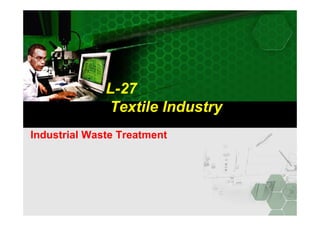L textile industry
•
10 j'aime•1,289 vues
The document discusses industrial waste treatment from the textile industry. Textile mills use various fibers like cotton, wool, or synthetics that generate different types of wastewater. The wastewater pollutants come from the fibers and chemicals used in processing. Cotton textile mills produce yarn from raw cotton through steps like opening, cleaning, picking, carding, drawing and spinning - which are dry operations that do not produce liquid waste. Wet processes like scouring, bleaching, mercerizing, dyeing and finishing generate wastewater with varying properties. Common chemicals used include enzymes, caustic soda, peroxides, and dyes. Textile mill waste is characterized by a pH of 9.8
Signaler
Partager
Signaler
Partager
Télécharger pour lire hors ligne

Recommandé
Recommandé
Contenu connexe
Tendances
Tendances (20)
PULP AND PAPER INDUSTRY: PROCESS, WASTE AND ITS MANAGEMENT

PULP AND PAPER INDUSTRY: PROCESS, WASTE AND ITS MANAGEMENT
Pulp and Paper Manufacturing and Treatment Of Waste Water 

Pulp and Paper Manufacturing and Treatment Of Waste Water
Cotton textile processing waste generation and effluent treatment

Cotton textile processing waste generation and effluent treatment
Environmental issues in textile industry of pakistan

Environmental issues in textile industry of pakistan
Paper and Pulp Industry- Pollution Control Techniques

Paper and Pulp Industry- Pollution Control Techniques
Developments in environment friendly functional finishes

Developments in environment friendly functional finishes
En vedette
En vedette (8)
Decolourization of textile waste water and dye effluent

Decolourization of textile waste water and dye effluent
L 4 characterization of industrial waste and sampling

L 4 characterization of industrial waste and sampling
Similaire à L textile industry
Similaire à L textile industry (20)
Lecture 2 tt 241 composotion of cotton and desizing

Lecture 2 tt 241 composotion of cotton and desizing
Cleaner production technologies for textiles iitd dec.10 12, 2008

Cleaner production technologies for textiles iitd dec.10 12, 2008
Cleaner production technologies for textiles iitd dec.10 12, 2008

Cleaner production technologies for textiles iitd dec.10 12, 2008
Cleaner production technologies for textiles iitd dec.10 12, 2008

Cleaner production technologies for textiles iitd dec.10 12, 2008
Plus de Dr. shrikant jahagirdar
Plus de Dr. shrikant jahagirdar (20)
L textile industry
- 1. L-27 Textile IndustryTextile Industry Industrial Waste Treatment
- 2. Introduction Textile mill uses cotton, wool or synthetic fibers. Waste water generated depends uponWaste water generated depends upon type of fiber used. The pollutants in the wastewater include - The fibers used and - Chemicals used in processing
- 4. Cotton Textile mill An integrated textile mill produces it yarn from raw cotton. Production of yarn from raw cotton includes steps such as - Opening and cleaning- Opening and cleaning - Picking - Carding - Drawing - Spinning - Winding and wrapping All these are dry operations and does not produce any liquid waste
- 5. The entire waste is generated from following operations - Slashing - Scouring All these are wet- Scouring - Desizing - Bleaching - Mercerizing - Dyeing and finishing All these are wet operations and produce liquid waste having varying properties
- 10. Wet Process in textile mill Chemicals used Scouring and Desizing (50% of total pollutional load) Enzymes, caustic soda, soda ash and detergents Bleaching (10 % load) Peroxides and hypo chlorides Mercerizing (small quantity Caustic sodaMercerizing (small quantity of waste) Caustic soda Dyeing Variety of dyes (reactive, vat, sulfur, basic etc), caustic soda etc finishing Starches, dextrines and synthetic waxes, resins etc
- 15. Composition of composite cotton textile mill waste Your Subtopics Go HereCharacteristics Value pH 9.8 - 11.8 Total alkalinity 17.35 mg/lit as CaCO3 BOD 760 mg/lit COD 1418 mg/lit Total Solids 6170 mg/lit Total Chromium 12.5 mg/lit
- 18. Objective Questions 1. For treatment of textile waste, neutralization tank is needed because of __________nature of wastewater. 2. pH of textile mill waste is in the range of2. pH of textile mill waste is in the range of ____. 3. Pick out odd one w r t textile mill Desizing, quilling, dyeing, proportioning
- 19. Theory Questions Q1. Draw a manufacturing process flow sheet for textile industry. Also mention sources of wastes. Q2. Give general characteristics of textileQ2. Give general characteristics of textile mill waste. Q3. Discuss treatment alternatives for textile mill waste.
